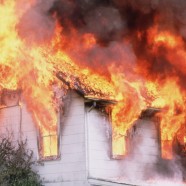
All the electricity comes into your home or business in one large stream that goes into the circuit breaker box or fuse box, where it’s divided into separate circuits, each of which controls the power to a certain number of appliances or outlets in a room. This division of power into separate streams or sections limits the damage that can happen if one circuit overloads.
Why Electrical Overloads are Dangerous
Each circuit breaker, fuse, and wire are rated to conduct a certain amount of electricity safely. If you exceed the demand on the materials in a circuit, excess heat can occur, which will expand and contract the coating on the older wires installed in your building. Sooner or later, this coating will get brittle and crack, leaving the wires inside exposed. If excess electricity is passed through this wire again it can spark, and the sparks can easily jump to old wood or insulation materials inside the walls. If you’re overloading your electrical circuits you may be creating the beginnings of a fire without ever even knowing it.
Dedicated Circuits
There are two different reasons why you might dedicate a separate circuit away from the rest of a room or area. First, some equipment calls on a large amount of electricity by itself. Commercial appliances such as restaurant fryers, walk-in freezers, and even home refrigerators can call on such a large percentage of the total power used that the safest way to handle them is to install a circuit dedicated to each item.
Secondly, if you have computers or other sensitive equipment in your home or business, you may not be able to afford the risk that a random hair dryer blows out the circuit and destroys memory or work you have in progress. By dedicating a circuit to only the electronics in a certain area, and by making sure the circuit and breaker are robust, you can protect your data from sudden surges and outages.
Each of these reasons serves to isolate sources of excess electrical usage, making sure the rest of the building isn’t subject to the dangers of overloading the circuit.
Renovation Tips
A building renovation is the perfect time to evaluate the wiring in your home or business. If you’re redoing a room or an entire home, sit down with your commercial electrician to determine where the large areas of electrical use will be. If you know multiple members of your family use their computers in the same office space, advise him so he can create a dedicated circuit to this room. The same goes for a basement prep storage area with multiple chest freezers or workshops with many power tools often in use.
If you’re redoing your business, especially if you plan to change the use of your building, completely redoing your commercial electrical installation is the safest way to go. It may take longer to build from the ground up, but if you don’t know the contractor who put in the previous wiring, you have no idea of the quality of materials or workmanship. The best insurance against electrical fires in a commercial renovation is to go with the materials and plans you know are safe.
Worst Case Scenario
If the worst happens and you have a problem before having your electrical wiring redone, the first sign of an electrical fire may be as simple as seeing smoke come out of a power outlet. It’s crucial that you don’t try to fix this problem yourself, as it’s very easy to get electrocuted during an electrical fire. If it’s safe:
- Turn off your power at the breaker box
- Get yourself and everyone else out of the building
- After you’re safe, call 911. Alert the fire department that it was an electrical fire, and let them know whether or not you were able to turn off the power.
Don’t try to go back inside to save your valuables, even if you don’t see flames. It’s most likely that the fire is building inside the walls, which can burst through ceilings and wallboard at any time.

Recent Comments